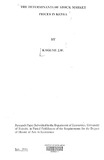| dc.description.abstract | Kenya lias made notable strides in all sectors of her economy since independence. Real Gross Domestic Product (GDP) grew at average rate of 4,8 per cent between 1964 and 1990. The prerequisites of sustained economic growth arc accumulation of savings and allocation of those savings to the most, productive investment. The role of the financial system is to mobilize savings and allocate them to consumption and investment.
Kenya has been able to invest a substantial proportion of her GDP and gross fixed capital formation has therefore increased. The performance of the Banking system (in terms of deposit mobilization) has been improving over the years. In addition, total lending of the Banking system has greatly increased over the years.
One area of the financial system which has not been active over the years is the stock market of the capital market. The primary market has played a minor role in mobilizing new capital. Most of the capital formation has been financed through loans obtained from the banking system. Further the number of participants in the Kenya stock market is very low compared to that of the developed countries. It was also observed that there has been a slow movement of stock market prices.
The objective of this paper was to explain the macroeconomic factors causing this trend ot stock prices for the period 1973 - 19X9.
The results indicate that money supply changes do riot have a significant influence on the stock market. Using partial correlation analysis of the constituents of changes of money supply, vve found that real domestic credit going to the private sector lias a positive and significant influence on stock prices. Real domestic credit going to the public sector was found to be negatively related to stock prices. Balance of payments as a proportion of GDP was found to be negatively related to stock prices.
Real income was found to have a positive and significant effect on stock prices. The expected rate of return on stocks was found to have a positive and statistically significant effect on stock prices. The effect of the demand for quasi-money was found to be negative and statistically significant. Inflation was found to lie negatively related to stock prices, but its effect was found to be statistically insignificant.
The stock market in Kenya was also found to be inefficient as stock prices do not adjust to expectations instantaneously. | en_US |



